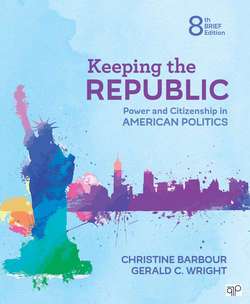Читать книгу Keeping the Republic - Christine Barbour - Страница 105
На сайте Литреса книга снята с продажи.
What Is Federalism?: Balancing power between national and state governments
ОглавлениеFederalism is a political system in which authority is divided between different levels of government (the national and state levels, in America’s case). Each level has some power independent of the other levels so that no level is entirely dependent on another for its existence. In the United States, federalism was a significant compromise between those who wanted stronger state governments and those who preferred a stronger national government.
federalism a political system in which power is divided between the central and regional units
The effects of federalism are all around us. We pay income taxes to the national government, which parcels out the money to the states, under certain conditions, to be spent on programs such as welfare, highways, and education. In most states, local schools are funded by local property taxes and run by local school boards (local governments are created under the authority of the state), and state universities are supported by state taxes and influenced by the state legislature. Even so, both state and local governments are subject to national legislation, such as the requirement that schools be open to students of all races, and both can be affected by national decisions about funding various programs. Sometimes the lines of responsibility can be extremely unclear. Witness the simultaneous presence, in many areas, of city police, county police, state police, and, at the national level, the Federal Bureau of Investigation (FBI), all coordinated, for some purposes, by the national Department of Homeland Security.
Even when a given responsibility lies at the state level, the national government frequently finds a way to enforce its will. For instance, it is up to the states to decide on the minimum drinking age for their citizens. In the 1970s, many states required people to be only eighteen or nineteen before they could legally buy alcohol; today all the states have a uniform drinking age of twenty-one. The change came about because interest groups persuaded officials in the federal—that is, national—government that the higher age would lead to fewer alcohol-related highway accidents and greater public safety. The federal government couldn’t pass a law setting a nationwide drinking age of twenty-one, but it could control the flow of highway money to the states. By withholding 5 percent of federal highway funds, which every state wants and needs, until a state raised the drinking age to twenty-one, Congress prevailed. This is an example of how the relations between levels of government work when neither level can directly force the other to do what it wants.
